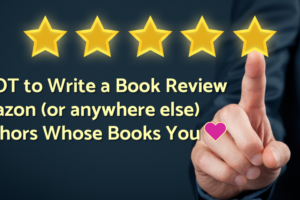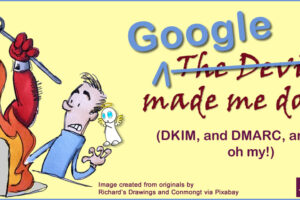[TfTi] Ya Think?!? – “Self-Publishing’s Output and Influence Continue to Grow”
“𝗣𝗼𝘄𝗲𝗿 𝘁𝗼 𝘁𝗵𝗲 𝗔𝘂𝘁𝗵𝗼𝗿”
That’s the headline inside the Publishers Weekly Daily newsletter from Nov 12 (while Yvonne and I were traveling. The first line is even more wonderful:
“It’s their [the authors’] world, and we’re just publishing in it.”
To back up that claim, the newsletter goes on:
“Authors keep finding new ways to get attention from the book business, and the self-publishing sector is proof, with the number of self-published titles with ISBNs rising 7.2% last year as traditional publishers acquire more heavily from the sector.”
Let’s break that down
Several points to unpack from that last quote:
- PW misses the point in saying indie authors are finding ways to get attention from the book business. The only thing that gets attention from that quarter is FIRST getting the attention of readers. That’s where savvy indie authors can have an advantage, by going directly to their audience.
For more details on how this indie publishing direct-to-reader approach compares to the way indie musicians and filmmakers operate, see The Indie Advantage. - While the growth in indie titles with ISBNs is impressive — and we urge all our clients to own their ISBNs — there are many more indie-published titles without ISBNs since, for example, Amazon KDP makes them optional for selling on “the world’s biggest bookstore.”
Even without knowing the numbers for those non-ISBN books, PW reports that 7.2% increase meant indie authors published over 2.6 million new titles in 2023. That compares to traditional publishers’ output falling 3.6% to just over 563,000 titles. - And finally, there’s reason to ask why an author who’s built a successful following independently would ever want to settle for the miserly royalties paid by traditional publishers. But that might be a lingering status symbol thing, eh?
For a deeper dive into the financial tradeoffs between indie, hybrid, and traditional publishing, see Weighing the investment in your book: Indie, Hybrid, or Traditional Publishing.
Take another look at #2. Indie authors are now putting out over 2 million more titles per year than traditional publishers.
And before you whine about quality, remember the main point of the PW article that we questioned in #3: the traditional publishers have increasingly been cherry-picking among indie authors who are doing the same quality work as the best the big houses can find on their own.
And if you’re an avid reader, you know the kind of sloppy, poorly written and edited work that sometimes manages to find its way to your hands with a traditional publisher’s imprint on it.
Producing quality work is essential. But it is fully within reach of indie authors who understand how to build their own team and invest the time and money necessary to do so.
The PW article linked in the newsletter quoted Kris Austin, CEO of Draft2Digital, as explaining:
“It is no longer just about how to self-publish a book; it’s matured into how to grow and sustain a successful publishing business.”
Elsewhere in the PW article, another term appears that helps capture what we mean when we tell authors that publishing a book means you are starting a new business: “savvy writer-entrepreneurs.”
What’s behind the growing success of Indie Authors?
At its simplest, the founder of Smashwords, Mark Coker, is quoted as saying the “secret sauce” of indie authors’ ability to go directly to their audience is found in one word: “control.”
“With more power [than traditional publishers allow] over their ‘pricing, promotion, and distribution,’ he asserted, indie authors are finding they can connect with their audiences ‘faster, and more profitably.’ “
We’ve written and spoken frequently urging authors to adopt “the Taylor Swift model” of book marketing. It appears that leaders in the indie publishing world are finding more and more authors are listening. Coker put it this way:
“Today, self-publishing is the ‘option of choice’ for many authors, especially for a younger generation of authors coming to market with new story ideas, greater social media and online marketing savvy, and a more entrepreneurial approach to their writing in the digital age.”
He identified as a “key factor” in the surge of indie author success that “self-published authors are able to form closer, more reader-pleasing relationships with their audience.”
There it is.
Indies are free, and fully empowered with modern technology, to form more reader-pleasing relationships with their audience.
Returning to two of our examples from The Indie Advantage, that’s precisely how Taylor treats her Swifties. And how Brandon Sanderson treats his readers.
Say it again: Power to the Author!


![featured image for blog post, [TfTi] Ya Think?!? 'Self-Publishing's Output and Influence Continue to Grow' by Tom Collins](https://masterbookbuilders.com/wp-content/uploads/2024/11/IndieAuthorInfluenceGrowing-900x400.jpg)



1 Comment
Leave your reply.